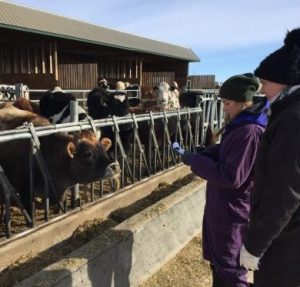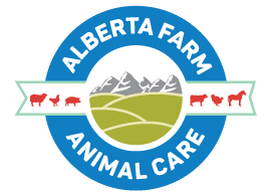Understanding the Barriers that Prevent Mitigation of Lameness on Alberta Dairy Farms
On behalf of the UCVM’s lameness team: Michelle van Huyssteen, Makaela Douglas and Karin Orsel
 Lameness is the third most common health problem and
Lameness is the third most common health problem and
My name is Makaela Douglas, and I am an undergraduate student studying biomedical sciences at the University of Calgary. It is my passion to work with animals and pursue a career in animal health. This past summer I had the opportunity to work alongside Michelle van Huyssteen on her thesis project for her master’s degree in veterinary medical sciences. As an extension of Michelle’s research, the aim of my project was to assess barriers that prevent producers from making changes on their farms to reduce lameness.
Common barriers producers are faced with when implementing farm-specific changes to target lameness is cost, often involving more time, and
During each farm visit, producers completed a questionnaire and Western Canadian Certified Hoof Trimming Association (
Graduate student Michelle van Huyssteen’ focus is mainly on understanding the producers’ perspective and how this impacts lameness prevalence on

Summer student Makaela Douglas filming cows walking on a flat surface.
Overall, 28 farms had a lameness prevalence of greater than 10%, and 14 of those farms had a lameness prevalence of over 20%. When studying the relationship between lameness prevalence and the current level of understanding of the general facts on lameness, many producers answered “High” on their knowledge of lameness, however, the average lameness prevalence for those individuals was still 18%. On the WCCHTA surveys, producers indicated that hoof trimmers were a main source of information for hoof health and lameness. Expectations of hoof trimmer visits were to reduce the number of lame cows, increase milk production and improve overall cow health. Interestingly, not all trimmers discuss the results of the trimming sessions, missing an opportunity to tackle lameness.
Hoof trimmers play an important role in raising awareness of lameness in dairy cattle and can provide useful information that producers can use to mitigate the issue on their farm. Therefore, discussion of hoof trimming records between the hoof trimmer and their clients should be a major focus during the trimming session. Also, veterinarians can use data available on
Michelle will be continuing the project by evaluating the RA using herd lameness prevalence estimates and hoof lesion records to determine if it accurately identifies risk for lameness on
This project is funded through the Industry and Market Development program of Alberta Agricultural and Forestry.
